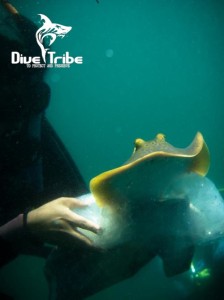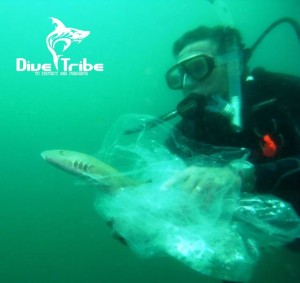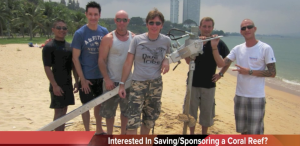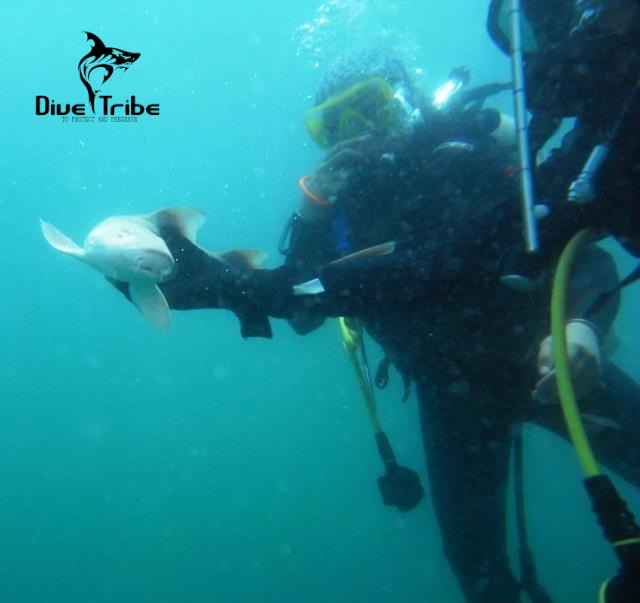What lives there? What direct effect are we having on the eco system of the ocean, and how can we help them thrive?
Currently, the seas around Pattaya in Thailand are under threat from overfishing, pollution and the large tourism influx that has taken place here over the last decade. Dive Tribe – an organization created almost three years ago – began monitoring the underwater situation here and decided that if nothing was done to protect the area a team would be assembled to start work on marine conservation and research.
Since that time, Dive Tribe has put together a very capable team and conducted a number of studies and projects (including mooring buoy projects, marine debris removal, beach clean-ups, mangrove replanting, reef monitoring, etc.) to help alleviate some of the pressure on the coral reefs and marine life in and around Pattaya. The organization works as a community with several dive centers in the area including Seafaris, Aquanauts, Oceanic Thailand and Adventure Divers. Dive Tribe has been working with students from Mahidol University and members of the public as well as teaching reef ecology and organizing specialist ecology field trips to the reefs in Pattaya for local and visiting universities as well as the general public. And this year, Dive Tribe branched out to write reef ecology field guides and create lectures as well as undertake reef reconstruction and conservation courses, which will be university sanctioned. So for all budding marine biologists now reading, there’s an opportunity starting in May to take part in one of the above-mentioned courses at participating dive centers.
Shark Release
The Shark Release program started in 2011 as a study on the dwindling shark population in Pattaya. In an attempt to address the situation, Dive Tribe released 60 sharks back into the seas in a move that was met with critical acclaim from other shark conservation organizations and dive centers. The release made the front page of many newspapers around the world and was a great success, not to mention a fun day out for everyone involved.
On March 9, 2013, Dive Tribe planned to repeat this success with a much larger release and a much more scientific approach.

Populations of top coral reef predators such as sharks and other elasmobranchs are declining at an accelerating pace due to human exploitation and habitat alteration and destruction. And the fact remains that bamboo sharks (Chiloscyllium punctatum) released by Dive Tribe are commonly found in most seafood restaurants in Pattaya. The consequences of this loss are known to cascade through the trophic levels, a finding that implies that sharks and other top predators influence trophic structure on the reefs. And the fact that sharks have the assumed role of moderating the functioning of the ecosystem means that the continued removal of these top predators will not only have serious repercussions on coral reefs, but will also threaten the very existence of the sharks, which may eventually face local or total extinction.
The plan for the March release was for the sharks to be released at five sites, with each shark tagged with a different colour according to the place of its release. The goal is to make it easier to determine movement of individuals between sites. Each individual will have its own unique identification number that can be cross-referenced with its genotype and demographics (sex, size, weight, condition, etc).
By tagging and genotyping the released sharks, not only can we find out if such releases are relevant, but we’ll also gather important information concerning migration and the movement of sharks. The development of shark sanctuaries or marine protected areas require this valuable information. And since little is known about sharks in Thailand, this work aims to address these gaps in our knowledge.
Following the shark release date of March 9, Dive Tribe organized a “Shark Search” for March 10 and 16, to coincide with one day and one week after the release. The hope is that each dive operator in the area will run frequent “Shark Search” dives to specifically look for these tagged sharks. The aim of the search is for divers to look for the released sharks and photograph them and, if possible, to note or photograph the attached tag. The most important thing is to identify the tag’s color (there are five options) and number, since each shark has its own unique color-coded and numbered tag. The teams works in groups, with each group releasing 15 sharks for a total of 75 sharks. And in the future, more sharks will be released from a captive breeding program.
This program has required much logistical work including the construction of a shark quarantine area, the assembly of correct tags and the safe transportation of sharks to the dive sites. We hope that the public will consider the consequences of eating sharks – not only for the health of the oceans but also for personal health reasons, since tests have shown that sharks can contain 42 times the allowable level of methyl mercury in their fins and flesh.

We give a big thank you to our sponsors – Sharkskin Australia and Big Blue Dive Center in Koh Tao – both of which have helped organize and finance part of this operation.
Continuing Conservation
Together with its partner stores, Dive Tribe has instigated one of the largest mooring buoy projects in Southeast Asia to date. The hope is to place a minimum of 50 buoys in and around the Pattaya area that will allow boats to moor up and thereby discontinue the practice of dropping anchors on the coral reefs or sand (after all, there is much sea life in sandy bottoms, too).
And what makes this project different from others is that, for the first time in Thailand, we will be using torque screwdrivers with nine tons of torque below the water’s surface to drive helix sand screws to depths of up to six meters, if necessary. And that means no more concrete blocks or tying to reefs and rocks.
This method is considered the most eco-friendly way forward and the screws can easily be removed if required. It’s a concept that not only protects the marine environment but helps aid Dive Tribe’s next project, too, which is aimed at acquiring protected marine status for several of the islands in the area. The main sponsor, Dragon Capital, has helped fund the machinery required for this project and the Getinge Group and Amari Hotels have sponsored reefs and buoys that will also help with protecting the area. Dive Tribe is also working with dive centers in the area to produce a number of courses that will be relevant to the region and research needs.

Working Together
The most important thing is that dive centers pull together as a community to protect their marine life. After all, this is why people come to the region to dive. Dive Tribe is also looking at building new coral nurseries in Pattaya and working on captive breeding programs for sharks that have already started to lay eggs.
With a continued goal of expanding marine research into new areas, Dive Tribe is looking for more dive centers on other islands and in other regions of Thailand for new projects next year that will help built a solid foundation for the protection of precious resources.
If you are interested in sponsoring a reef or you work with a dive center and would like to learn more about our courses and the chance to become a marine conservation officer, please contact us: [email protected]


